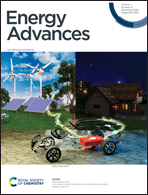Flexible “polymer-in-ceramic” composite solid electrolyte PI–PEO0.2–PDA@LATP0.8 and its ionic conductivity†
Abstract
Increasing the proportion of inorganic electrolytes in organic–inorganic composite electrolytes can significantly improve the ionic conductivity of composite electrolytes. However, this method is confronted with some problems, such as the uneven dispersion of inorganic electrolytes and the aggregation of nanoparticles, which results in a worse performance of the electrolytes’ interface. In this study, we had the dopamine hydrochloride molecules self-polymerized on the surface of inorganic ionic conductor lithium titanium aluminum phosphate (LATP) particles to obtain PDA-coated LATP nanoparticles. Then, the coated LATP particles were composited with PEO at a ratio of 80 : 20, with the LATP's evenly dispersed in the PEO, and no aggregation happened. On adding a small amount of electrolyte (5 μL cm−2, 1 M Li TFSI), the ionic conductivity of the electrospun PI-loaded PEO0.2–PDA@LATP0.8 flexible composite solid electrolyte reached 2.07 × 10−4 at 30 °C and 2.05 × 10−3 S cm−1 at 80 °C. NCM811‖Li batteries assembled with this electrolyte had an initial discharge capacity of 178.0 mA h g−1 at 30 °C, and still remained at 172.1 mA h g−1 (96.7%) after 200 cycles. The research shows that there are three main conduction pathways of Li+ in this electrolyte: through the segments of the polymer chains, through the interface between the polymer and inorganic ionic conductor, and through the passage composed of a continuous inorganic ionic conductor. Further results show that the coating of LATP by PDA does not block the transmission of Li+ both inside the crystal and at the crystal interface of LATP.



 Please wait while we load your content...
Please wait while we load your content...